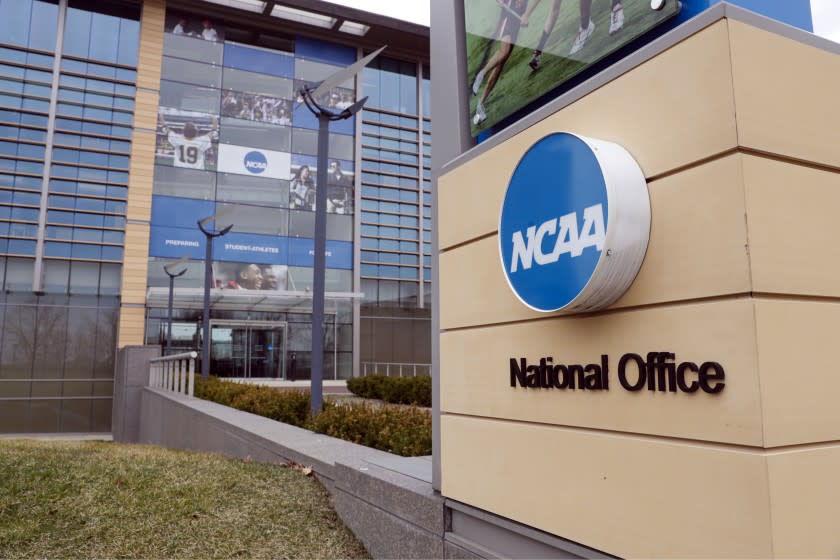NCAA approves extra year of eligibility for spring athletes, with a catch

The NCAA Division I Council voted Monday to approve an extra year of eligibility for all spring sport athletes who had their seasons canceled because of COVID-19, but the generosity will come with a caveat for seniors:
If you decide to return to campus, what you were getting before in scholarship money might be less — a lot less.
The Council, “in a nod to the financial uncertainty faced by higher education,” provided its schools the opportunity to give athletes whose eligibility was set to expire this spring the chance to come back without requiring that athletics aid be awarded to each player at the same level.
While seniors could see their scholarship agreements altered — in some cases decreased to zero aid — underclassmen and incoming freshmen will not see a difference.
Coaches will have to have some tough conversations with seniors who want another shot at finishing their careers on a championship note but would have to pay for more of their education out of pocket.
“The Council’s decision gives individual schools the flexibility to make decisions at a campus level,” Council chair M. Grace Calhoun, Penn’s athletic director, said in a statement. “The Board of Governors encouraged conferences and schools to take action in the best interest of student-athletes and their communities, and now schools have the opportunity to do that.”
The Council adjusted financial aid rules to allow teams to carry more players on scholarship to account for an influx of newcomers with any seniors who decide to stay.
NCAA athletes start their careers with five years to play four seasons in their sport. All current spring sports athletes will now have six years to complete their eligibility.
Athletes in winter sports, like basketball and ice hockey, were not included in the ruling because much or all of their regular seasons were completed.
Monday’s vote put an end to several weeks of speculation among athletes, coaches and athletic administrators that started March 12 when the NCAA canceled its remaining championship events amid coronavirus fears.
The next day, perhaps sensing the emotional whiplash of having thousands of athletic careers end so suddenly, the NCAA’s Division I Council Coordination Committee announced its leadership had agreed that “eligibility relief is appropriate for all Division I student-athletes who participated in spring sports,” leading to athletes rejoicing while coaches and college sports’ power brokers collectively asked one question: How?
The NCAA said it would need time to iron out the details.
But, as time passed, the financial picture quickly worsened. Last week, the NCAA announced it would pay out only $225 million of a projected $600-million annual distribution to Division I schools, and, with the postponement of the Tokyo Olympics, it became clear there is no guarantee that schools will be able to milk the football cash cow this fall.
Naturally, doubts that the NCAA would actually vote for eligibility relief began to creep in, and Monday’s vote began to feel like empathy against economics.
Turned out, with the NCAA handing athletes eligibility relief and the schools the flexibility on how to accomplish it, there was no clear winner or loser.
“I think this was a decision made with the heart, trying to support student-athletes that didn’t have the opportunity they’d thought they’d have,” Pac-12 Commissioner Larry Scott said when reached by phone Monday night. “But when the head kicks in, and you figure out how you’re going to pay for it and what other implications there will be for student-athletes, I think that’s a recognition that for many conferences and schools there’s a fiscal reality to this.”
Scott said that the Pac-12 membership supported the NCAA’s decision and inferred that some would consider going all the way in supporting returning seniors.
“I know we’ve got schools that have the strong view they would not reduce aid for a senior that was coming back,” Scott said.
Of course, outside the Power Five conferences, each senior’s decision will carry more weight in the overall budget. A USA Today analysis said bringing back seniors in spring sports could cost athletic departments anywhere from $500,000 to $900,000.
While it would appear this ruling could make college sports’ rich only richer, that may not be the case, particularly when many spring sports athletes are on partial scholarships or choose to walk on.
“You’re talking about an equality issue,” USC baseball coach Jason Gill said Friday. “It costs $74,000 a year to go to USC. It costs $18,000 per year to go to Long Beach State. So, you can come back, but you have to pay your way? Well, we’re going to have guys transfer out that can’t afford it.”
There is also an issue of fairness on the field.
“If UCLA has 12 seniors and USC has five, is that equal?” Gill said, using a hypothetical, although the Trojans did have five seniors this year.
The USC women’s lacrosse team, which started 6-0 before having its season canceled, has 11 seniors.
“I know as a coach, I certainly don’t want to have to choose who gets that [scholarship] and who can’t,” USC women’s lacrosse coach Lindsey Munday said Friday. “Not all schools are going to be able to afford that, so then are you planning on this very uneven playing field? It’s tough. It’s really tough.”
With an unprecedented scenario like this, no decision was going to hit all the right notes. Officials from schools of all sizes are trying to give the NCAA the benefit of the doubt on this one.
“I think competitive advantages go completely out the window when you’re dealing with something like this,” Loyola Marymount athletic director Craig Pintens said when reached Monday. “That’s something obviously people are going to worry about, but I’m just happy and thankful that a decision was made in the best interest of student-athletes everywhere. The competition aspect of it will work itself out.”

